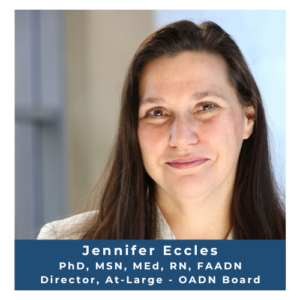Addressing the U.S. and Global Nursing Workforce Shortage: The Role of Associate Degree Nursing Programs
OADN wishes you a happy June! This month is joyful, full of celebrations such as graduations, Pride, Juneteenth, Father’s Day, and weddings, and filled with the hope of nature in full bloom. June is a month of renewal, growth, and light. The sun is at its peak, and we are halfway through 2025 already! It’s a time of resetting, rethinking, and joy, which makes June a WONDERFUL time for innovation!
celebrations such as graduations, Pride, Juneteenth, Father’s Day, and weddings, and filled with the hope of nature in full bloom. June is a month of renewal, growth, and light. The sun is at its peak, and we are halfway through 2025 already! It’s a time of resetting, rethinking, and joy, which makes June a WONDERFUL time for innovation!
The United States is grappling with a significant nursing workforce shortage
Our country, indeed the world, is experiencing a critical nursing workforce shortage, a challenge that has profound implications for healthcare delivery nationwide and globally. According to the U.S. Bureau of Labor Statistics (BLS) (2025), employment of registered nurses (RNs) is projected to grow by 6% from 2023 to 2033, faster than the average for all occupations. This growth is expected to result in approximately 194,500 registered nurse positions becoming available each year over the next decade. A significant portion of these openings will likely stem from workforce turnover, including individuals changing careers or retiring from the profession. (Bureau of Labor Statistics, 2025). However, the nursing shortage in the America’s is only 3% of the world’s nursing workforce shortage. According to the World Health Organization (2020), there will be a global shortage of over 10 million nurses by 2030, with the most severe impacts expected in low- and middle-income countries.
Addressing the Shortage: The Role of OADN and Associate Degree Nursing Programs
In the United States, associate degree nursing (ADN) programs are well-positioned to help address both the national and global nursing workforce shortages. In this context, Associate Degree in Nursing programs are crucial in addressing the nursing shortage. As an ADN program, YOU can make a difference! Assess the needs in your service area. Do you need to graduate more nurses in general? Is there a need for specialty areas? Can you team up with local healthcare agencies to educate new nurses to meet these needs? Guess what? You can! And OADN can help!
The Organization for Associate Degree Nursing serves as the national voice for community-based college nursing education and the associate degree pathway. OADN supports over 1,100 colleges offering ADN programs, which are instrumental in preparing competent, entry-level nurses to meet the healthcare needs of diverse populations. OADN’s initiatives focus on several key areas to bolster the nursing workforce:
• Advocacy and Policy Engagement: OADN actively engages with educational partners and policymakers to highlight the critical role of ADN programs in providing accessible, quality nursing education. By advocating for policies that support ADN programs, OADN ensures that these programs receive the necessary resources and recognition to continue producing educated registered nurses.
• Research and Data Collection: Recognizing the importance of data-driven decision-making, OADN has launched a Research Hub to collect and disseminate key data about faculty, students, and programs. This initiative supports ongoing research efforts aimed at enhancing ADN education and addressing workforce challenges.
• Social Mission and Health Equity: In collaboration with the Social Mission Metrics Initiative, OADN has worked to assess and improve the social mission of ADN programs. This includes evaluating how programs address social determinants of health, health disparities, and the needs of underserved communities, thereby promoting health equity across the healthcare system. (Dobkin et. al., 2024)
While ADN programs are essential to solving U.S. workforce needs, they also have a role to play in addressing the global nursing shortage.
U.S. nursing schools can help meet this global need by providing training pathways for international students to become nurses in the U.S. or return to strengthen their country’s health systems. Additionally, ADN programs can expand global health competencies so graduates can contribute to international health efforts.
Here’s the thing: make sure your ADN program is putting out enough graduates to meet the needs of the communities you serve. Then, see if you can help meet the needs of other communities nearby and branch out further to help the global community.
Through its leadership, advocacy, and focus on innovation and access, OADN is uniquely positioned to help ADN programs strengthen the domestic workforce while also contributing to global solutions. By expanding and supporting associate degree nursing programs, the U.S. can address local healthcare gaps and play a collaborative role in responding to the worldwide call for more nurses. Thank you for your part in this work!
Jennifer Eccles PhD, MSN, MEd, RN, FAADN
Director, At-Large
OADN Board of Directors
Bureau of Labor Statistics, U.S. Department of Labor, Occupational Outlook Handbook, Registered Nurses, at https://www.bls.gov/ooh/healthcare/registered-nurses.htm (visited May 10, 2025).
Dobkin, F., Wester, K, Stamps, D., García, R., Elliott, D., Hoffman, B., Beard, K. & Batra, S. (2024). Analysis of social mission at associate degree nursing programs in the United States. Teaching and Learning in Nursing, 19(3), 288-292, https://doi.org/10.1016/j.teln.2024.04.014
World Health Organization. (2025). State of the World’s Nursing 2025, at https://www.who.int/publications/i/item/9789240110236/ (visited May 10, 2025).
Organization for Associate Degree Nursing. (2025). A Transformative Voice in Healthcare Leadership, at https://oadn.org/about/ (visited May 10, 2025).
